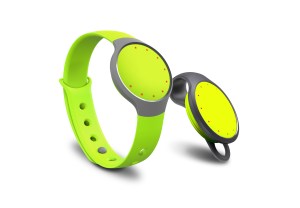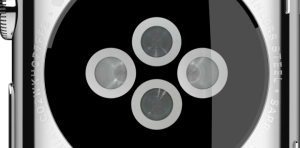Jawbone’s $150 Up24 may be the best fitness tracker of 2014.
But the “fitness tracker” category of wearables is getting crowded, and Jawbone’s competitors are bringing new features into the category that fitness-minded consumers will surely buy.
Chief among those features is the heartbeat sensor, which can work in concert with the accelerometer and the app to track things like calories burned. The optical sensor typically faces downward from the bottom of the wearable, and it shines either visible or infrared light through the skin to detect pulse. The feature is already being built into higher-priced smartwatch devices like the Moto 365 and the Apple Watch.
Over the coming year, heartbeat sensors will become common in fitness trackers, and “table stakes” for the more expensive ones.
Commoditization
The main ingredient in most health wearables — the accelerometer — has become a commodity. The accelerometer is the sensor inside the wearable that counts steps and tracks sleep patterns, with the help of some fancy software algorithms. The price of that type of sensor has plummeted as every smartphone maker is buying them by the truck load.
The truth is, simple fitness trackers aren’t that expensive to make. Consumer demand is high, and as there are lots of trackers on the market now, prices are dropping. And many people who are just discovering fitness wearables would rather buy a less expensive one than spend $250 on a fitness watch or more on a full-blown smartwatch.
Xiaomi sells its Mi Band wearable for $13. Misfit recently began selling a new $50 version of its flagship $100 Shine wearable. The new “Flash” wearable does everything the Shine does (tells time, counts steps, tracks sleep, etc.), but it uses a plastic cover material instead of aluminum.
Consumers will expect more for their dollar from fitness trackers that cost more than $100. And this includes the ability to track heartbeat and calories burned. Fitbit is one of the first movers — its new Surge watch includes an optical heart rate sensor on the back.
And so far Jawbone has not released a fitness tracker or watch with a sizable display. The company has said publicly that it’s not interested in making wearables with displays.
But this leaves Jawbone in that first (and least expensive) class of wearables, with devices like the Xiaomi Mi Band and the Misfit Flash (and many others), in the eyes of consumers. If Jawbone truly wants to stick with the no-screen approach, it will have to start building truly impressive features into its bracelets, starting with a heart rate monitor.
Some analysts have been hinting at the possibility of a heartbeat-sensing Jawbone device.
“We at Smartwatch Group expect Jawbone to launch a product in Q4 2014 that will be geared more towards the health market,” says Pascal Koenig of the Smartwatch Group in Switzerland. “Based on the acquisition of BodyMedia, Jawbone has significant knowledge doing this, including experience on the regulatory side.”
(The health relevance of fitness trackers and other wearable devices will be discussed at VentureBeat’s HealthBeat conference next Monday and Tuesday, October 27-28. Seats are still available. Register now.)
A Jawbone spokesperson chose not to comment on the matter.
Smartwatch threat
And, of course, the “fitness tracker” and the “fitness watch” categories are under pressure from true smartwatches, like the forthcoming Apple Watch, which threaten to swallow the two less expensive categories.
As the feature sets and price points of true smartwatches improve, consumers may decide that step counting and sleep tracking are just features in a much wider set of “smartwatch features.” Many will be hesitant to buy devices that do only those things. Better to pay a little more for a smartwatch that acts more like a smartphone on the wrist.
In defense, lower-priced fitness wearables are already starting to incorporate smartwatch-like features. The new Fitbit Surge, for example, can display texts, ID phone calls, and control the music player on a paired smartphone.
Garmin’s Vivofit (which has a sizable display for a fitness tracker) alerts the wearer when calls, texts, emails, and calendar events have come in on the smartphone it’s paired with. Xiaomi’s Mi Band can even act as an authentication bracelet to unlock paired phones and tablets, with no pin or passkey needed.
Christmas is coming fast. Lots of wearables will be jammed into lots of stockings. Jawbone better find a way to sweeten up the feature sets in its bracelets … or somebody else might just eat its figgy pudding this year.
VentureBeat's mission is to be a digital town square for technical decision-makers to gain knowledge about transformative enterprise technology and transact. Learn More


